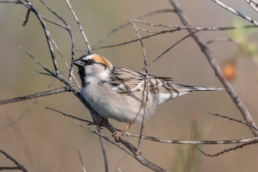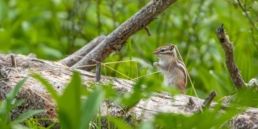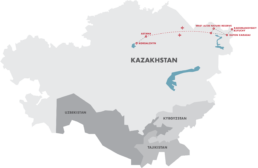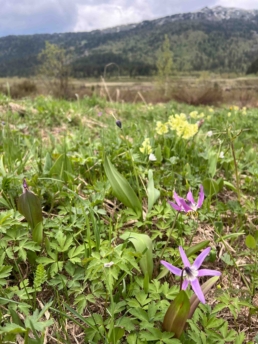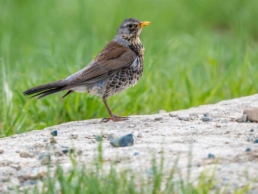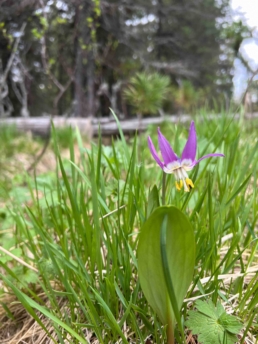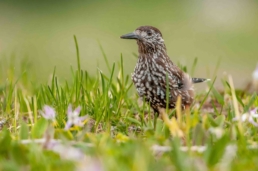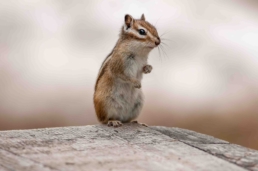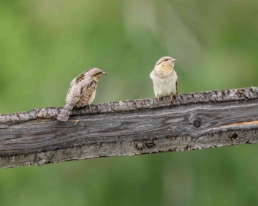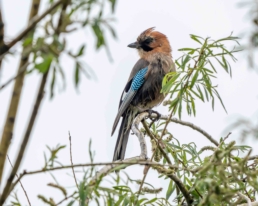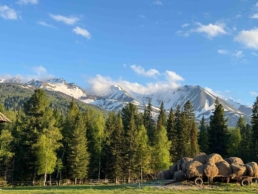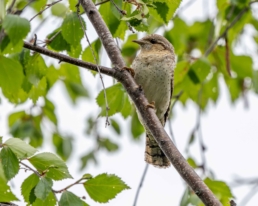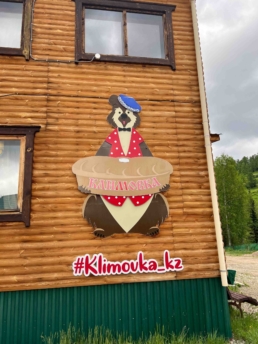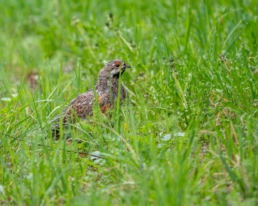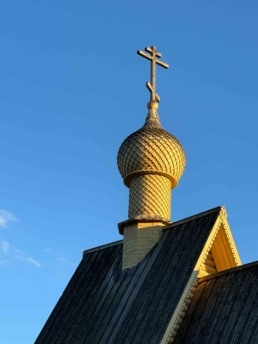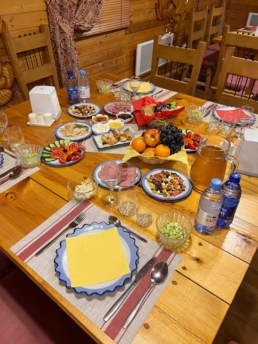Your Kazakhstan itinerary
Day 1: Departure and arrival in Astana
Clients depart from home for the capital of Kazakhstan, Astana. This futuristic city resembles those of the oil states of Dubai and the United Emirates. Kazakhstan has an abundance of natural resources and has profited from the vast reserves of oil and gas, but also minerals like uranium and zinc. After arrival in Astana we check-in to our comfortable tourist hotel. If desired we are able to enjoy a small city tour of the city.
Night: Comfortable tourist hotel in Astana
Day 2: Astana surroundings
We start our tour this morning with excursions around Astana. We are in search of waterfowl that use the lakes around the city as a stopover during their migration north. Our top target, however, will be a small passerine, the Pine Bunting, which will likely be accompanied by several Red-footed Falcons and numerous Pallid Harriers. In the evening we will check in to our comfortable Astana hotel!
Night: Comfortable tourist hotel in Astana
Day 3: Korgalzhyn State Nature Reserve
An early morning rise will see us depart at 0500 for the breathtaking drive to Korgalzhyn State Nature Reserve. This region is surprisingly little known, even within Kazakhstan, but the abundance of birdlife here has recently attracted a nomination for UNESCO World Heritage Site status. The vast wetland area, a combination of virgin steppe and lakes, is home to Wolves, Marmots and Saiga. However, it is the birds that are the real attraction. A crossroads of two migration routes, the wetlands here act as a giant motorway junction service station for birds (Lake Tengiz alone can feed 15 million birds during migration).
This area, most of which is protected as a ‘Zapovednik’ (national nature reserve), is home to the world’s most northerly population of Greater Flamingo. One of over 300 species of birds which represents one of the largest wildfowl populations in Asia. Other notable residents include pelicans, cranes, and a variety of birds of prey.
Our main targets here are nesting groups of the globally endangered Sociable Lapwing, which we have “staked out” for you. There are many other excellent attractions in this vast landscape. We can find roadside colonies of Black-winged Pratincoles and White-winged Black Terns in glorious breeding plumage. The steppe lakes are dotted with migrant shorebirds such as Red-necked Phalaropes, Spotted Redshank, Terek Sandpiper, Little- and Temminck’s Stints. Ruff can be observed displaying in all their finery. These innumerable wetlands and lakes should also produce breeding Dalmatian Pelican, Great Bittern, White-headed Duck, Red-necked and Eared Grebes, Whooper Swan, Greylag Goose, Red-crested Pochard and Caspian Terns. More exclusive still are the close colonies of splendid Great Black-headed Gulls, with a supporting cast of Steppe and Slender-billed Gull!
The damp grassy steppe is home to elegant Demoiselle Cranes while nearby scattered scrub should hold Booted Warbler, Pallid Harrier, and gorgeous Red-footed Falcons. We should find two other very unique birds today – Black and White-winged Larks which are often numerous along the roadside. Both species are confined to the Central Asian steppes and are a major drawcard for any visiting birder! In the evening we return to Nur-Sultan where we will enjoy a lovely dinner.
Night: Comfortable tourist hotel in Astana
Day 4 - 5: Ust-Kamenogorsk
We will venture above the treeline. In this high-altitude habitat, we are in search of goodies like Ptarmigan, Willow Grouse and Dotterel. Amongst the dwarf birch, we should find Bluethroat and possibly Siberian Rubythroat. Grey Marmots will be calling in the valley, and the rocky slopes are home to Altai Pikas. At the same time, a Lapland Fritillary may flutter past during its search for its host plant. Around Katon Karagay we can explore the nearby forest where Oriental Cuckoos will be calling, and the droppings of Brown Bear may reveal their presence. At these lower elevations, around Katon Karagay flowers and butterflies are abundant and sure to be a spectacle.
On the outskirts of town birds such as Pine Bunting, Common Redstart and Eastern Black Kite can prove quite common.
Night: Basic lodge Katon
Day 6 - 7: Katon Karagay
For 3 full days, we immerse ourselves in the awe-inspiring mountains surrounding Karakol, a city nestled on the eastern shores of Lake Yssyk Kol. Our journey takes us to remarkable altitudes, including an excursion to Chon Ashuu Pass—the highest point of our tour—reaching an impressive 3,822 meters (12,539 feet). Venturing far beyond the tree line, we search for a unique set of alpine bird species. The nearby fast-flowing river is home to both White-bellied and Brown Dippers, while Lammergeyers soar overhead.
In the lush meadows, we have a chance to spot one of the world’s most enigmatic waders—the elusive Ibisbill. Eversmann’s Redstart, along with Himalayan and Brown Accentors, are common sightings at these heights. We’ll take our time to seek out the stunning White-browed Tit-Warbler, as well as its vibrant companion, the Güldenstädt’s Redstart. In the open patches of mature, mixed deciduous and coniferous forests, we’ll find Greenish and Hume’s Warblers frequently.
In Barskoon, we dedicate a full day to exploring this majestic high-altitude landscape, rich with alpine specialists. Black-throated, Altai, and Brown Accentors, Sulphur-bellied Warbler, Red-mantled Rosefinch, White-tailed Rubythroat, White-winged Grosbeak, and the striking White-browed (Severtzov’s) Tit-Warbler are all on our target list. As we ascend higher near a gold mine, at an altitude of 10,500 feet, we’ll be on the lookout for Lammergeier, Himalayan Griffon, Red-billed and Yellow-billed Choughs, Plain Mountain-Finches, White-winged (Güldenstädt’s) Redstart, and the magnificent Himalayan Snowcock, which we have a strong chance of encountering.
Night: Comfortable tourist hotel in Karakol
Day 8 - 11: Rakhmanovskiy Klyuchi
In the coming days we explore possibly the most beautiful mountain lake in Central Asia, the Rakhmanovskiy Lakes. The long and bumpy road will take us over a pass at an elevation of around 2000 m. During our ascent, we will stop and explore several forest types. We hope to find the greyish form of Eurasian Bullfinch, Pine Grosbeak and maybe a Dark-sided Flycatcher if we are lucky. The gorgeous Brown Shrike is likely to be seen perched on the top of a thorny bush while Golden Eagle may be observed hunting for small marmots. In the afternoon, we will arrive at our luxurious lodge high in the mountains.
At the lake itself, we should secure close views of the interesting White-winged Scoter. Sometimes we are lucky enough to find a pair of Black-throated Divers joining the scoters. Siberian Rubythroats will be singing from their posts along the lake. Black-throated Thrushes, Siberian- and Willow Tits are finding food for their recently hatched chicks. Inside the scrub, we can find Greenish-, Hume’s- and Dusky Warblers, while open patches of forest hold Eversmann’s Redstarts, Siberian Nuthatches and Three-toed Woodpeckers. Pacific Swifts and large flocks of Red-billed Choughs rule the skies above. The substantial walk up the slopes through flower-filled alpine meadows will guarantee fantastic scenery. Here we are in the habitat of Plain- and Brandt’s Mountain Finches, Güldenstädt’s Redstart, Asian Rosy Finch and Altai Accentor. In 2013 we found a breeding pair of Pallas’s Bunting here. We will end each day with a lovely dinner on the terrace overlooking the lake.
On day 11, we leave the gorgeous lake behind us for a full day of driving which will bring us back to Ust-Kamenogorsk. We will aim to arrive back at our hotel in the early evening.
Night: Comfortable tourist lodge in Rakhmanovskiy.
Night day 11: Comfortable tourist hotel in Ust-Kamenogorsk
Day 12 - 15: West-Altai Nature Reserve
Passing through glowing agricultural fields as we drive northwards to the Russian border (a 2.5-hour drive) where we will be lodging in a lovely cabin in the forest. We will start with a visit to the wet fields around the city of Ridder, where Pallas’s Grasshopper Warbler and Long-tailed Rosefinch are our main objectives. In the hedges, Red-backed Shrikes are common while Azure Tits forage nearby. Here we hope to add some more aquatic species like the White-crowned Penduline Tit and, less likely, Blyth’s Reed Warbler.
We will explore the forests near the West-Altai Nature Reserve. This reserve is the largest in Kazakhstan, at 56,000 hectares, and gives us countless options for wildlife viewings. Starting around our lodge, we have a reasonable chance of finding Ural Owl, Taiga Flycatcher and Olive-backed Pipit. Sometimes even Siberian Jay may appear on one of the feeders! In these dark coniferous forests we are sure to hear the call of the White’s Thrush and if lucky, maybe come eye-to-eye with one of these subtle beauties. Commoner birds here include Red-flanked Bluetail, Black-throated Thrush and Hawfinch. The botanists amongst us will enjoy the thousands of species of plants surrounding us – Siberian Adder’s Tongue and Pink Rhodiola being the most interesting. The threatened Altai Weasel has a stronghold in this splendid reserve, and we have a chance of seeing Siberian Chipmunks and Common Shrews.
We will have one last walk before checking out and driving back to Ust-Kamenogorsk. We will board our domestic flight at 2000, which will take us back to the capital.
Night: Klimovka Camp in Ridder.
Night day 15: Comfortable tourist hotel in Astana
Day 16: Astana to home
A transfer will be provided very early this morning to Nursultan Nazarbayev International Airport (airport code NQZ), in time for the Turkish Airlines flight to Istanbul, currently scheduled to depart at 3:20 a.m.
Tour information
Focus
- Birds
- Mammals
- Vast unique landscapes
Group size
Min 6 - Max 8
The group will be always led by one wildlife leader and one culture guide.
What's included in the Price?
All transport, including the domestic return flight between Astana and Ust-Kamenogorsk. All accommodations in twin rooming. All meals. All permits and national park entrances. Please note: Drinks, tips, possible visas and items of a personal nature including travel insurance, are not included.
Accomodation
Throughout our journey in Kazakhstan, we will venture primarily off the beaten track, immersing ourselves in the authentic beauty and culture of this remarkable country. The Altai region, while rarely visited by Western tourists, offers abundant wildlife and stunning landscapes. However, with its remote roads come more basic accommodations. Be prepared for simple hotels and guesthouses, where you’ll be welcomed by warm and hospitable locals eager to share their corner of the world. Most accommodations will feature shared shower and WC facilities. However, in Ust-Kamenogorsk and the capital, Astana, we will stay in comfortable tourism hotels, ensuring a pleasant end to our adventure.
Difficulty
During our expeditions, we may embark on long journeys, some of which may traverse poor or unpaved roads. However, these extensive travels serve to highlight the vastness and adventure of the region. Throughout the journey, we’ll travel in comfort using a reliable coach for transportation. When it comes to walking, the tours are designed to be primarily easy to moderate, even in the high elevations of the Altai Mountains. Most of our walking excursions involve short distances on flat terrain or downhill paths, ensuring that participants can comfortably explore the stunning landscapes and natural wonders of Central Asia.
Flights
International flights are not included in the pricing. Please connect with the RBT office to find out your best connection to Central Asia.
Clothing - What to pack?
For our expedition to Central Asia, it’s important to pack a variety of clothing to accommodate the diverse climates and activities we’ll encounter. Lightweight, easily washable, and quick-drying clothes are essential for the hot steppe and desert regions, along with sunglasses and a sun hat for sun protection. However, don’t forget to pack some lightweight yet warm layered clothing for higher altitudes, where temperatures can drop significantly. This includes a warm hat, fleece, and light gloves to keep you cozy. Additionally, a light waterproof jacket is recommended to shield against unexpected rain showers. When it comes to footwear, opt for light yet sturdy walking boots that can handle various terrains. It’s advisable to avoid shorts to protect yourself from the sun, as the region can be conservative in dress. While people in the cities tend to dress more casually in western clothing, it’s still a good idea to respect local customs by dressing modestly. If needed, laundry facilities are available at hotels in larger towns such as Astana and Ust-Kamenogorsk offering convenience for longer stays.
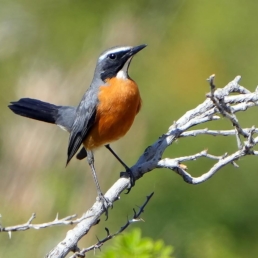
Related tours
Ornithological expedition in the Kazakh Altai
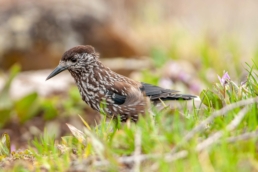
Exciting fall migration in a Palearctic hotspot
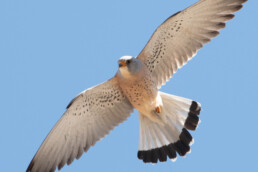
Floating hide Photography expedition
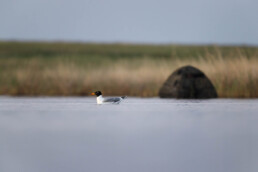
Spring migration in Central Asia
